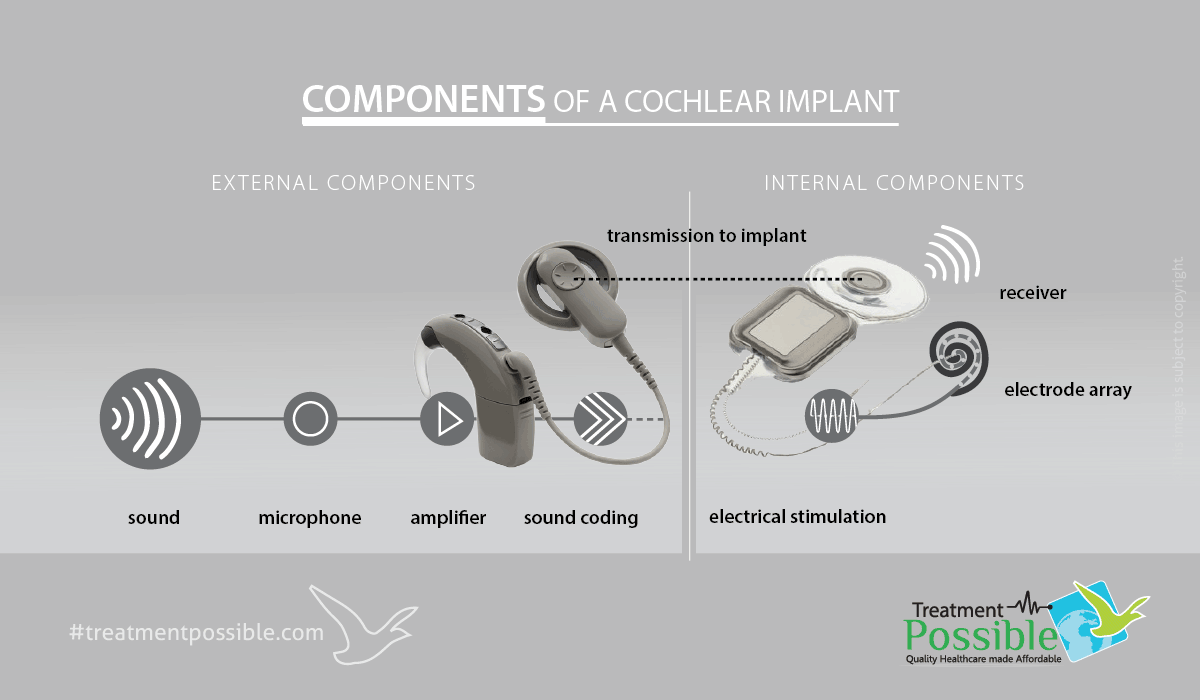Cochlear Implant in India at an Affordable Cost!
Cochlear implantation is a complex and expensive procedure. Many underdeveloped countries have limited access to this service. While countries like US and UK provide quality options for cochlear implants, they can be expensive. But India is a popular destination for this procedure due to its affordable and high-quality options. It has numerous cochlear implant facilities, experienced ENT specialists and a comprehensive approach to cochlear implantation.

What are the Benefits of a Cochlear implant?
A cochlear implant is a specialized electronic device that replaces the function of a damaged inner ear.
- Doctors recommend it for people with severe hearing loss due to inner-ear damage who receive limited benefits from hearing aids.
- It bypasses damaged portions of the ear and delivers sound signals directly to the hearing nerve in the brain.
- Medical professionals have successfully used cochlear implants to treat tinnitus.
- Doctors use them to help children born with severe hearing loss.
Did you know?
Cochlear implants done at an earlier age stands the highest chance of improvements in hearing as the brain is still in the learning stage.
Avg. cost is 40% – 50% less in India!
It ranges from $17000 – $18000 for unilateral implants (one ear) and $32000 – $34000 for bilateral implants (both ears)
How does a Cochlear Implant work?
A cochlear implant is a hearing device that bypasses damaged parts of the inner ear (cochlea) and directly stimulates the auditory nerve, sending sound signals to the brain for interpretation, unlike hearing aids which simply amplify sound.
The cochlear implant has an external and an internal part. The external part consists of the following components:
- Microphone (one or more) – Generally placed somewhere behind the ear to pick up sounds from the outside world.
- Speech processor – Filters out unnecessary noise and converts sound into digital code.
- Transmitter – Sends signals and power to the receiver inside the ear by the process of electromagnetic induction.

The internal implant part consists of the following components:
- Receiver – Receives signals and then processes the sounds into electric impulses.
- Electrode array – Placed deep within the cochlea. It stimulates the cochlear nerve and thus sends signals to the brain.
It takes time and training to learn to interpret the signals received from a cochlear implant. Within a year of use, most people with cochlear implants make considerable gains in understanding speech.
The Implantation Procedure
The implantation procedure consists of three steps:
Step 1 – Implantation: First, the surgeon surgically fits the Internal components. After the incision heals, usually about two to six weeks after surgery, the external device is placed.
Step 2 – Mapping & Switch On: Next, audiologist programs the speech processor and progressively tunes & adjusts the cochlear implant as the patient begins their new hearing journey.
Step 3 – Auditory-Verbal Therapy: The patient attends several follow-up visits over a few months to adjust the sound signals. If the patient is a child or has been deaf since birth, they should undergo extensive rehabilitation to improve their speech, language and hearing skills.
How is the surgery performed?
- Step 1: The anaesthesiologist administers general anaesthesia. Once the patient is asleep, the surgeon shaves a small area of hair around the ear where the internal implant will be placed. Then, the surgeon makes a small incision (cut) behind the ear and creates a small “seat” in the bone to hold and protect the implant.
- Step 2: The surgeon makes a tiny hole in the cochlea and inserts the electrodes. After securing the implant behind the ear, they close the skin with dissolvable stitches that do not need removal.
- Step 3: After completing the surgery, the medical team moves the patient to the recovery unit for close monitoring. Once they confirm there are no side effects, they discharge the patient either a few hours after surgery or the following day.
Patient Testimonial:
“The treatment was very good; the doctors were good. It was more than we expected!”
— Ephrem (Naomi’s Father)
Get a Cochlear Implant in Just 3 Easy Steps

Fill the Form Below
We will set up a free online call with an ENT specialist.

Get A Doctor’s Opinion
Get all the information that you need i.e. the treatment plan, pre-surgery tests, cost estimate for the treatment and answers to all your queries.

Plan Your Surgery in India
Fill out necessary forms and documents and travel to India for a successful treatment!
Do you have a query?
For more information or any other query feel free to contact us.
Frequently Asked Questions (FAQ’s):
What is the difference between a cochlear implant and a hearing aid?
A cochlear implant and a hearing aid are different devices which have diferent range of functions.
| Hearing Aid | Cochlear Implant |
|---|---|
| It uses a microphone, amplifier, and speaker to make sounds louder. | It bypasses the damaged part of the ear and sends the sound sensations directly to the hearing nerve in the brain. It captures sound with a microphone, converts it into a digital code with a speech processor and transmits it to a receiver which converts it into electrical impulses which is then sent to the brain. |
| It is not surgically implanted. Instead worn inside or behind the ear. | It has two sets of components: Internal and external component. The internal component is surgically implanted. |
| Cannot help in fixing severe hearing loss | Used to fix severe hearing loss |
